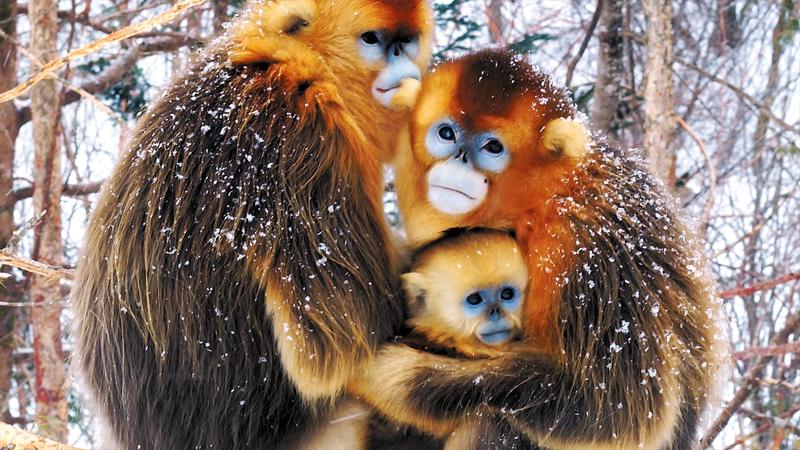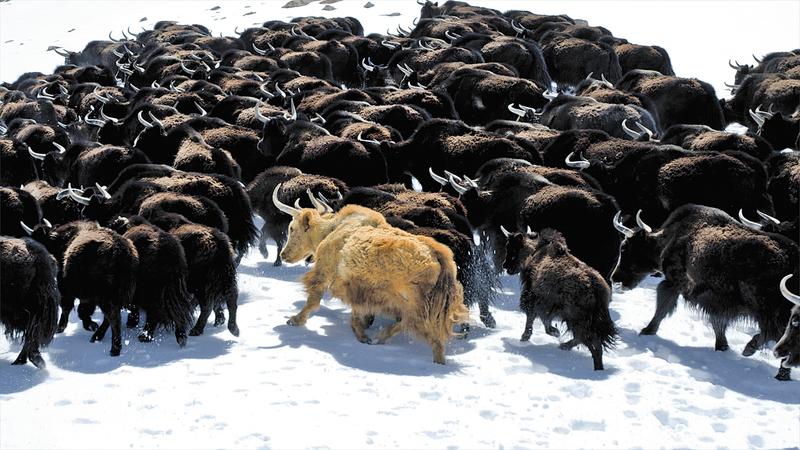The latest and fourth season of the popular documentary series Aerial China gives a perspective that is both stunning and informative, Xu Fan reports.
 With staggering bird's-eye view footage, the new season of Aerial China captures wildlife at its most majestic, including soaring egrets, golden snub-nosed monkeys, migrating naked carp and wild golden yaks. (PHOTO PROVIDED TO CHINA DAILY)
With staggering bird's-eye view footage, the new season of Aerial China captures wildlife at its most majestic, including soaring egrets, golden snub-nosed monkeys, migrating naked carp and wild golden yaks. (PHOTO PROVIDED TO CHINA DAILY)
Continuing with its iconic style of capturing scenes from a bird's-eye view, the highly rated documentary series Aerial China recently returned to the small screen, with the latest and fourth season broadcasting on CCTV-1 from Nov 7 and on CCTV-9 from Nov 9.
As the finale of the series, which was launched seven years ago, the new season was shot across 11 provincial-level regions, including Hong Kong, Macao and Taiwan, making Aerial China the first of its kind to cover vast areas of the country's diverse landscape.
With the improved biological environment ... it has become much easier to spot rare species in the wild.
Yu Le, documentary director
After serving as the chief director for the first and third seasons, Yu Le, who is back at the helm for the fourth season, says shooting for the latest season started in the spring of 2020.
"The cinematography team has accumulated a lot of experience from the previous three seasons, making us more capable to follow wild animals while avoiding disrupting them," says Yu.
From Bryde's whales swimming in the sea along the Guangxi Zhuang autonomous region to migrating naked carp in the salty Qinghai Lake, the documentary has snapped a lot of intriguing wildlife moments.
An episode showing the Tibet autonomous region records how brown bears prepare for winter and black-necked cranes undergo their annual migration between March and April. In another story, featuring Hubei province, members of a family of golden snub-nosed monkeys are seen huddling together to get warm on a snowy branch in the Shennongjia Forestry District. The photography team also encountered three wild golden yaks — or one-hundredth of the species' total population in the world — running with a herd of common yaks on the Tibetan plateau.
 With staggering bird's-eye view footage, the new season of Aerial China captures wildlife at its most majestic, including soaring egrets, golden snub-nosed monkeys, migrating naked carp and wild golden yaks. (PHOTO PROVIDED TO CHINA DAILY)
With staggering bird's-eye view footage, the new season of Aerial China captures wildlife at its most majestic, including soaring egrets, golden snub-nosed monkeys, migrating naked carp and wild golden yaks. (PHOTO PROVIDED TO CHINA DAILY)
"China has endeavored to protect endangered wildlife species and their habitats in recent years. With the improved biological environment, we are surprised and happy to find that it has become much easier to spot rare species in the wild," says Yu.
Taking Tibetan antelopes as an example, the director says the plateau-based creatures were difficult to encounter in the past, but the expansion of their population and enhanced research on their living patterns have allowed the camera crew to tailor plans to follow the animals.
With most close-ups for the season shot by photographers from helicopters or cameras installed on drones, the director says the responses of different animals to the filming devices varied.
"Some of the wild animals were alert to the machines, but some creatures were curious about the lens," he recalls, adding that a gray heron was caught attempting to peck a camera when the filming team was in Liaoning province.
"Unlike the animals living on land or flying in the sky, the creatures in water usually pay less attention to such machines. The pivotal moment for a successful shot depends on the mood of the animals or how good the weather is," Yu says.
 With staggering bird's-eye view footage, the new season of Aerial China captures wildlife at its most majestic, including soaring egrets, golden snub-nosed monkeys, migrating naked carp and wild golden yaks. (PHOTO PROVIDED TO CHINA DAILY)
With staggering bird's-eye view footage, the new season of Aerial China captures wildlife at its most majestic, including soaring egrets, golden snub-nosed monkeys, migrating naked carp and wild golden yaks. (PHOTO PROVIDED TO CHINA DAILY)
For most audiences who have already watched some aerial shots of natural resource-rich regions in previous works, the new season of the series might be a fresh experience to look at densely populated metropolises from a great height. Despite facing regulations in using drones to take photos from the sky in Hong Kong and Macao, the crew came up with a solution: When the drones snapped some interesting activity from the sky, the production team would contact the organizers of such events to see if they could be informed in advance the next time to obtain more footage.
In an effort to fully demonstrate China's huge transformation over the past decade, the documentary series consulted experts from different fields such as geology, climatology, archaeology and ethnology to help select the most attractive shooting sites, with a ratio of 10:1, or shortlisting one final shoot location from 10 candidates.
With the final season, Aerial China has used a total of 73 helicopters and 320 drones to shoot footage over an area of 900,000 kilometers, and recruited around 1,000 staffers, according to the producers. A total of more than 30 teams were assigned to shoot in different cities for the fourth season.
 With staggering bird's-eye view footage, the new season of Aerial China captures wildlife at its most majestic, including soaring egrets, golden snub-nosed monkeys, migrating naked carp and wild golden yaks. (PHOTO PROVIDED TO CHINA DAILY)
With staggering bird's-eye view footage, the new season of Aerial China captures wildlife at its most majestic, including soaring egrets, golden snub-nosed monkeys, migrating naked carp and wild golden yaks. (PHOTO PROVIDED TO CHINA DAILY)
Sometimes, the shooting demanded physical strength of the camera crew. Yu recalls that the team dispatched to Tibet took a helicopter ride at an altitude of around 5,000 meters from the northern slope of Qomolangma, which is also known as Mount Everest. They flew higher through the clouds to reach an altitude of over 7,500 meters and captured the precious footage of the summit of Mount Namjagbarwa, which soars at 7,782 meters above sea level.
"Because of the thin air at that altitude, the photographers had to carry oxygen cylinders. But when they saw the first rays of sunlight hit Qomolangma in the morning, the magnificent and unforgettable scene made us believe that the hardship had paid off," says Yu.
The previous three seasons have been watched by 850 million TV viewers and seen online over 140 million times. For fans of the series, the director says he hopes that the new season will draw a bigger audience with its distinctive perspective to show them China like never seen before.
Contact the writer at xufan@chinadaily.com.cn


